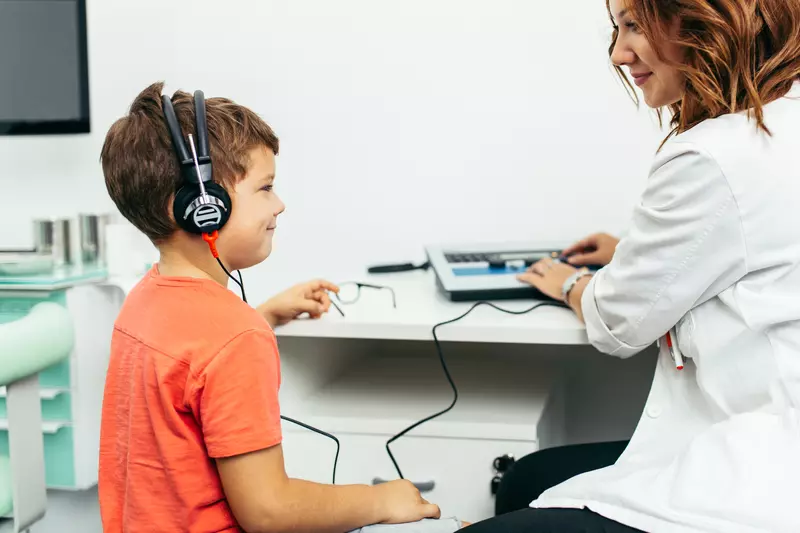- AdventHealth

At AdventHealth, we’re dedicated to high-quality, whole-health care for your entire family, which is why our pediatric audiologists work directly with our pediatric rehabilitation team to ensure your child gets the best possible hearing health care. From the first few days after birth all the way through to adulthood, our team of experts provides compassionate care to your child and their hearing health needs. To learn more about these special services and how they provide personalized care for your child, we spoke with Matthew D. Williams, AuD.
Testing Children for Hearing Loss from Birth
“At AdventHealth, we screen every baby born in our facilities for hearing loss before they’re discharged,” says Dr. Williams. “The reason we do this is twofold — first, because children whose hearing loss is identified early and who receive early intervention are more likely to function at the level of their peers by the time they enter school. Second, because Florida state law requires it. While we follow state guidelines, of course, it’s our dedication to your baby’s whole-health that comes first.”
If a baby doesn’t receive a hearing screening because they were born at a birthing center or at home, they can still be referred to our outpatient pediatric facilities for a hearing test.
“It’s important your child's hearing loss is diagnosed by one month old in order to provide early intervention. A baby with hearing loss present at birth should start treatment around three months old, but no later than 6 months. This is an important time for speech and language development.”
“There are two primary screening tests for newborns, and both are painless. They take only a few minutes and are best done while your baby’s sleeping, because any movement or extra noise could interfere with the results.”
An otoacoustic emission test (OAE), uses a tiny microphone placed in your baby's ear. Sounds are then transmitted into their ear, and the sounds emitted by the inner ear are recorded in the ear canal. The type of hearing loss and severity of a hearing loss cannot be determined with this test, but if your baby has a hearing loss, there will be little or no emission of sound.
An auditory brainstem response (ABR) test uses electrodes placed on the forehead and ears while the baby is resting. An acoustic stimulus is then presented to each ear, either through headphones or insert-earphones. An analysis of the activity in the auditory nerve reveals whether there’s a potential hearing loss.
If your baby doesn’t pass their hearing screening, they’ll be referred to an audiologist for a diagnostic ABR test. The diagnostic test is similar to the screening but takes significantly more time — this test may take up to an hour and will help determine the severity of the hearing loss.
Testing Infants and Toddlers for Hearing Loss
“If your child is at risk of hearing loss or is showing signs they may have hearing loss, additional testing will be required,” explains Dr. Williams. “These tests for infants between the ages of seven months and two years may include the OAE and the ABR again, as well as a simple behavioral audiometry test which includes the use of hand-held sound stimuli representing various frequency ranges, for example a drum, rattle or bell could be used. This test is used to observe your infant's behavior in response to certain sounds.”
“Another test we use is called sound field testing. This test uses visual reinforcement while your infant is exposed to a variety of sounds through loudspeakers. Your infant is trained to turn toward any sound source, and when they respond they’re rewarded through an entertaining visual image or toy.”
“For children two to four years old, we can use conditioned play audiometry (CPA). It’s used for young children mature enough to take the test. CPA testing provides specific information about their hearing loss, and it’s often made into a game where your child is asked to do something with a toy like touch it, toss it in a bucket or something similar every time a sound is heard. For this test your child will need to wear headphones or insert earphones and it relies on their active participation and usually takes about a half an hour. If your child doesn’t pass these tests, then they will likely need a more in-depth evaluation by the audiologist.”
“At this age, recurrent ear infections can be common and often create a temporary hearing loss in the affected ear. An additional test that we use to determine if there is any fluid in the ear is tympanometry,” says Dr. Williams.
Tympanometry is a test to help determine how your child's middle ear is functioning. The testing device puts air pressure into their ear canal, causing their ear drum to move. The mobility of their eardrum is then measured to determine how well the structure functions. The test doesn’t determine if your child is hearing or not but can detect changes in the pressure or fluid in the ear which can affect hearing.
Testing Older Children for Hearing Loss and Audio Processing Disorders
Pure tone audiometry is like conditioned play, but simply requires your child to raise their hand or press a button when they hear the sound. Different frequencies or pitches are presented at different loudness levels to determine their level of hearing. All the previously mentioned tests (OAE, ABR, Tympanometry) are also used to verify auditory function and help determine the type and severity of a hearing loss.
“If a child is shown to have normal hearing with the diagnostic hearing evaluation, but still report difficulty hearing or understanding speech, they may have an auditory processing disorder (APD). This disorder affects about five percent of children and it means their brain may not be processing the sounds they’re hearing properly,” said Dr. Williams.
To determine if your child has an APD, our audiologists will administer a series of tests in a sound-treated room. Most of the tests for APD require your child be at least 7 years old and can take up to two hours. They will need to be able to vocalize a response to various situations, listening to words or phrases and repeating back what they hear. Children with an APD often have similar symptoms as those with an attention deficit disorder. They are easily distracted and often can’t focus, especially in noisy environments. They often have academic difficulties and have a hard time following multi-step directions.
Get Your Child’s Hearing Tested
You child’s whole-health is important to us. Our team of audiologists and rehabilitation specialists will work together to ensure your child receives the highest quality of care available because even a mild hearing loss can affect your child’s language and educational development. If you believe your child may have hearing loss or an APD, please visit our site or call Call407-303-8080 to schedule a screening with one of our expert audiologists.



